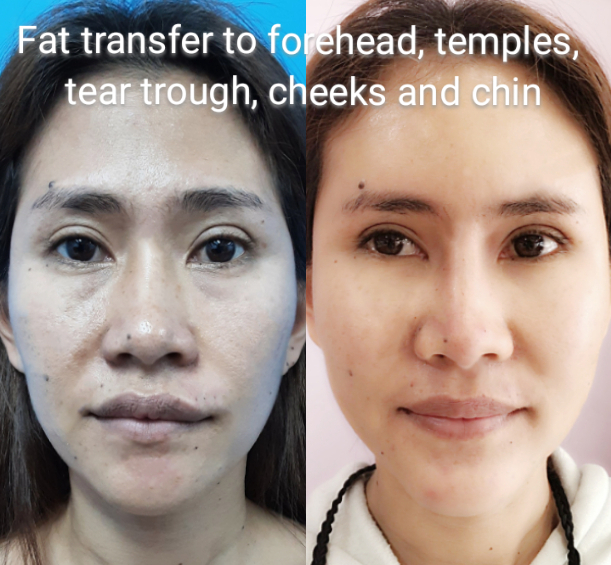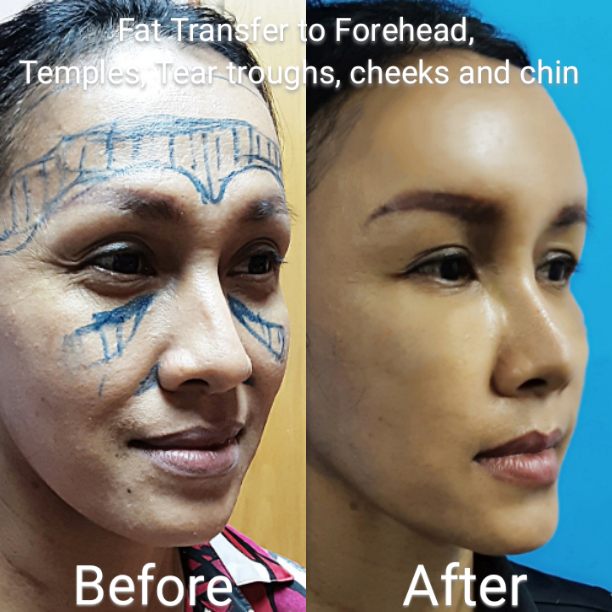Fat Transfer (Fat Grafting) to Face
.png)
How Fat Transfer Procedures Work?
Have you ever heard someone complain about their "big boobs"? Usually there is someone else who responds, "Well, give me some of it if you don't want it!" Ok, that's not really how fat transfer works, but you get the picture.
You are a good candidate if you have excess fat in the good donor sites-the abdomen, thighs and buttocks. The plastic surgeon uses small needle liposuction to extract the fat. Then he washes, filters and purifies the fat before injecting it into the treatment site. This purification is very important to improve the survivability of the fatty tissue once it is introduced to the treatment site.
The benefit of using your own fat to plump up the lips, the face and even the breasts and buttocks is that the results are natural and long-lasting.
.png)
.png)
Fat Injections to the Face
Fat transfer is often known as fat grafting, and it is a natural, minimally invasive surgical procedure to move fat from an area of the body where it is plentiful, and transferring it to the face to restore lost volume. The fat is gently removed using modern liposuction techniques, and is then prepared for injection into the face. This produces a very natural appearance, and there is little risk of infection or rejection of the fat by the body. Common treatment areas include the forehead, sunken temples, retracted chin, nasolabial folds (between the nose and the lips), marionette lines (between the lips and chin), flattened cheeks, sagging jaws, and hollows under the eyes.
Facial Fat Transfer Procedure
Fat transfer is a fairly gentle procedure, but there are several steps to the process. First, liposuction techniques are used to remove fat from predetermined areas of the body, such as the stomach, hips, or thighs. This is done through tiny incisions that leave almost no scarring.
The fat that has been retrieved is then gently prepared for injection, using minimal manipulation. Fat is carefully injected into the lines, hollows, and depressions of the face to rejuvenate and recontour, using fine cannulas (tubes) placed through tiny incisions. The surgeon may overfill the treated areas somewhat to compensate for the percentage of fat cells that will not survive.
Techniques used for improving fat survival
Injection technique is important. Cells should be injected under low pressure, so as not to injure them. They should also be injected in very small droplets so the surrounding tissues can get the blood supply quickly into all the injected fat. When you inject fat in large clumps only the fat cells on the outside of the clump get blood supply on time. The rest of the cells inside the large clump starve of blood supply and die. When they die they release their contents, which in turn causes an inflammatory reaction in the tissues.This inflammatory reaction can interfere with the blood supply of the cells which had taken, and cause scarring. Injecting in small droplets (Micro Fat) is slow and tedious, but necessary to ensure graft survival.
Protecting the cells after they have been injected is the last step in ensuring graft survival. The key is to prevent swelling and trauma to the area. In the body, I use compression garments and give instructions to the patient not put pressure or lay on the area where we grafted too long. The area is protected for two weeks because of the time needed for the graft to take. In the face, I advise patients to sleep with the head of the bed elevated to prevent swelling, and to sleep on their back so as to avoid trauma from awkward sleeping positions.
During the fat transfer surgery, the surgeon will often overfill the face with some extra fat to compensate for the inevitability of the cells that will not survive the transfer and will be reabsorbed by the body. This leaves enough healthy cells to establish a blood supply and become permanent in the face. After about six months following surgery, the fat that remains should be relatively permanent, producing lasting improvement.
Can facial volume restoration fix sagging skin?
The goal of fat transfer, of course, is to restore the youth and contour of the aging face. Sagging skin is partially caused by facial volume loss, so restoring some of that volume with fat transfer can help with mild to moderate skin sagging. However, more extensive sagging skin may not tighten up enough following treatment, so patients with moderate to severe facial skin laxity should consider a more comprehensive anti-aging procedure instead, such as a facelift.
Facial fat transfer complications are generally rare, as the procedure is gentle and safe. However, as with any surgical procedure, there are small risks involved, which may include:
• Infection
• Anesthesia complications
• Fat calcification
• Over or under correction (poor aesthetic result)
Be sure to go over the risks and side effects of the procedure during your consultation so you can be on the lookout for any potential complications. A talented surgeon and your own diligent pre- and post-operative care efforts will go a long way in preventing complications.
The transferred fat cells will continue to live in the area in which they were injected, establishing a blood supply and behaving like any other fat cell. This means that if a significant amount of weight is gained or lost, these cells could expand or shrink, affecting the overall results of the procedure. This is why patients are encouraged to be at a stable weight before the procedure, and maintain that weight following surgery, in order to preserve results.
Regenerative properties of your own fat tissue
In addition to making your facial structure look younger, fat injections can also improve your skin. More than a decade ago, researchers discovered that your own adipose tissue contains adult stem cells. These are cells found in your own fat that have regenerative properties. When the procedure is performed correctly, fat grafting can provide a new source of blood supply for your existing tissue and skin. Thus, the fat not only adds volume to your face, but it also has these natural regenerative properties to make your face look more youthful.


.png)
.jpg)
Unlike the traditional fat graft procedures that use thick cannulas for injecting fat, Nano Fat Graft uses fine size nano cannulas to inject nano fat cells smaller than the normal sized ones.
Since it can insert fine size fat cells into several layers, the engraftment rate is expected to be high. It not only improves volume but also creates the most suitable and beautiful facial line to create a young and attractive looking face.
Uses nano cannula with a thin needle for fat graft!
Fat Graft Point 2
Even and set injection to multiple layers
Benefits of Nano Fat Graft
- Smooth skin with no bumpy surface
- No fat lumps felt
- Can be done to delicate areas that need fine injection such as lachrymal groove
- Since nano fat cells are injected by nano cannula, stable fat graft is done in detailed shapes
Recovery from this is fairly quick. The liposuction is performed with a local and since there you don't need to remove a lot of fat, there is little trauma to the tissue. Transplanting the fat is as simple as a few injections. So, the real recovery is from the liposuction. You may have some swelling and bruising, but this will dissipate over the next few days. The difficult part is making sure the fat survives the transplant and that it doesn't reabsorb too quickly. (The fat usually dissolve about 30% in 2-week time but it will last life-long after that time)
Though this is safe filler, there are some complications that can occur from fat transfer. Infection is a possible with any surgical procedure, so it is important that you follow your surgeon's post-op instructions. Another problem is asymmetry or overfilling.
This is a very detailed process and if you don't have a surgeon who is experienced in it or he rushes through the procedure, you could wind up a lopsided face or overly-plumped lips. The good thing is that the fat gradually reabsorbs into your body so this is not a permanent problem.
The best way to ensure that the surgery goes as planned is to choose the right plastic surgeon. He must be board certified and is experienced in this procedure. Be clear when you talk about your expectations and what area you would like to fill out.
This is a safe way to add volume wherever you want it. You can fill out your face, your buttocks, and breasts-whatever you want to be rounder or plumper without putting synthetic products in your body.